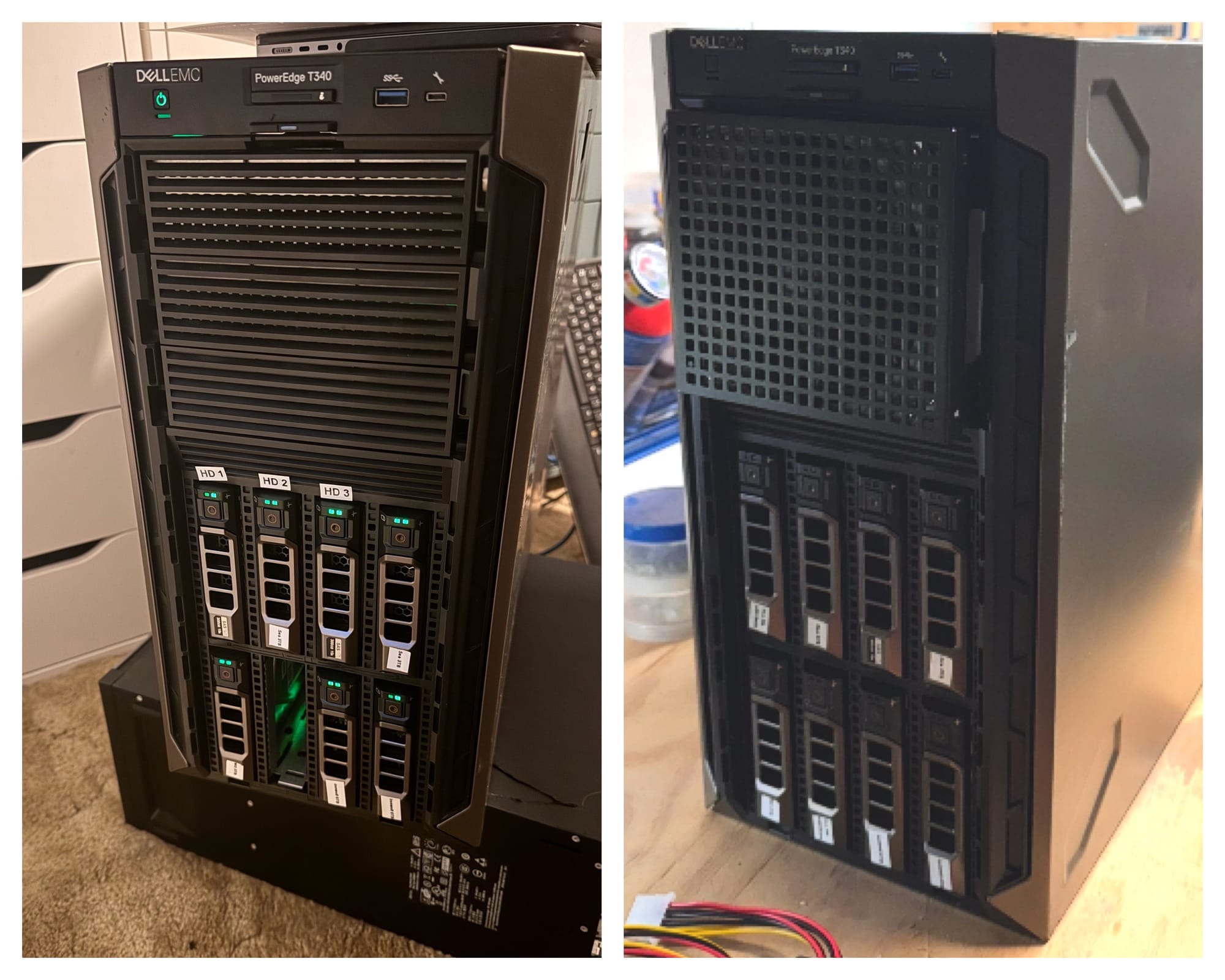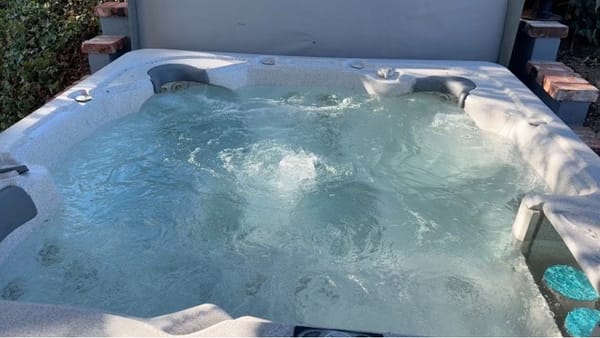Homelab - Dell EMC Poweredge T430
Upgrading from old laptops to a larger server for managing my homelab. Plex & Homebridge and a slew of other docker containers.
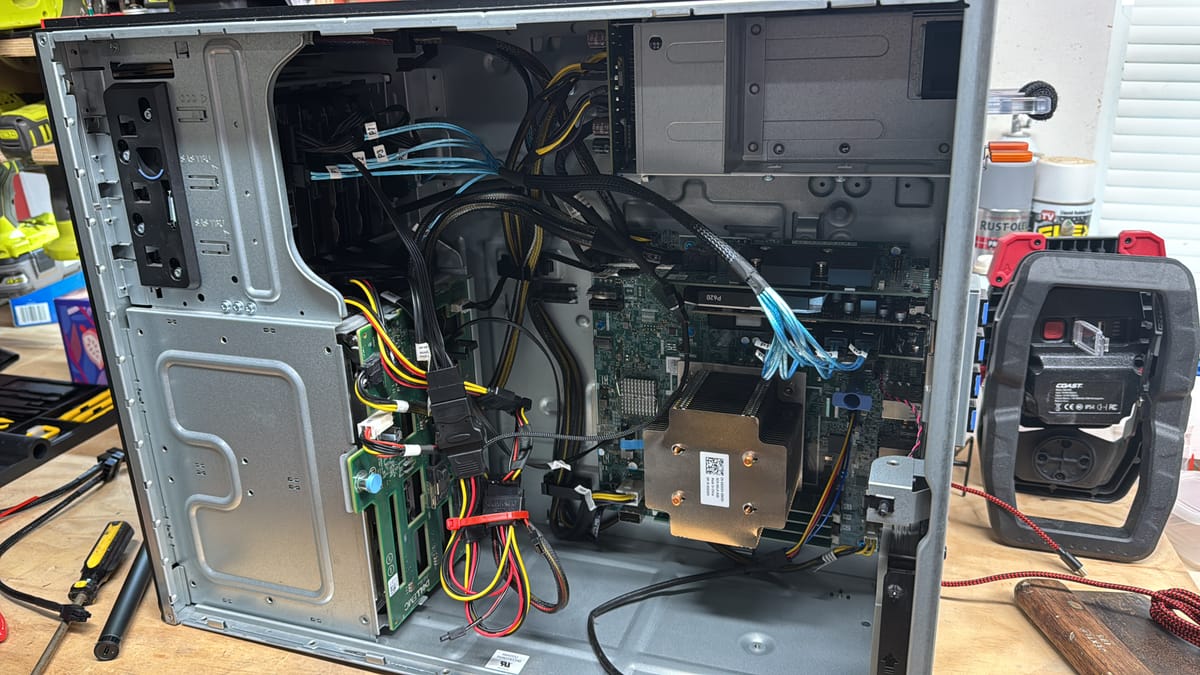
I'm working on a new build for a 2018 Dell EMC Poweredge T430 which will be running Unraid and hosting my Plex server and storage for my media. Yes it's 2025 and I'm using a 2018 Dell server but wow you can get this for cheap!
Doing some research before purchasing I found this post from Eric Schewe of The Picky Sysadmin back in 2019 stating that he wasn't able to get a processor, in his case a E-2176G CPU to use the onboard graphics to do any Plex transcoding. To solve this he went and purchased a Quatro P620 graphics card (2GB ram) to use its NVENC and the capability of using HEVC video files. Following his lead I purchased the same videocard for $40 on ebay so I can manage to have Plex do any transcoding if needed.
Specs
Dell EMC PowerEdge T340 Server
Intel Xeon E-2124 (9th gen Coffee Lake) 3.30 GHz CPU - Socket 1151
PERC H330 Raid Controller
3 X 300 Gb Hard Drives (8 bays)
2 X 495 W EPP Power Supply
32 GB (4x8GB) DDR4 Unbuffered DIMMs
Current Stats
Stats wise the server operates just fine with the 1 cpu with 4 cores and 4 threads. Memory usage wise things are OK but could be better if I upgraded from 32 to 64gb maxing it out. As you can see in the screenshots the Cache/ Buffers is what is taking up a lot of it.
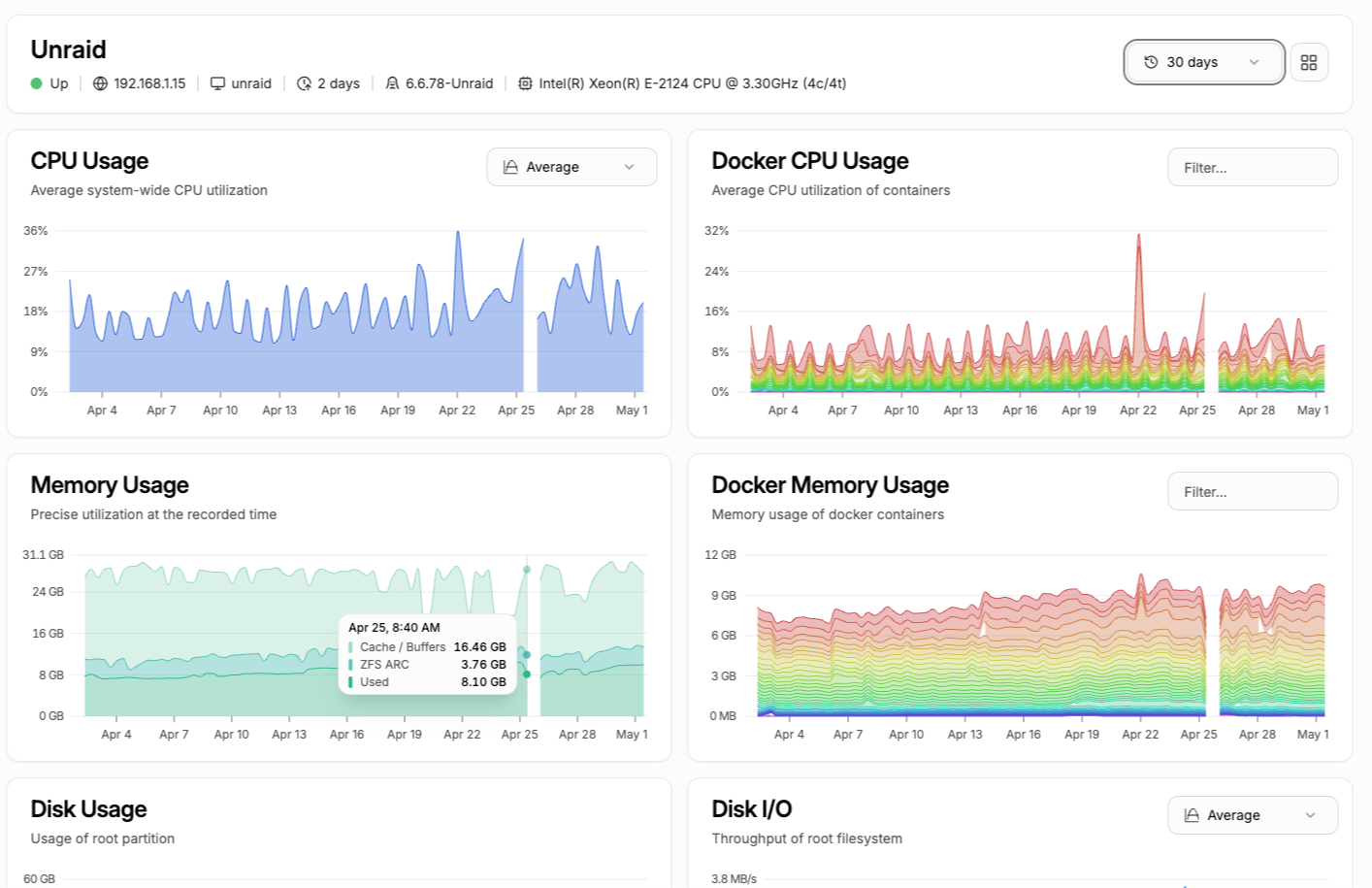

Potential upgrades
CPU
I'm reading that the CPU in this is 4 codes and 4 threads but I'm finding that you can get an 8 core 8 thread for about $120 on ebay. That may be something I dig further into.
Memory
This server supports up to 64GB of ram with 4 slots. Currently it has 32GB of ram but swapping out the 8GB each to 16GB each would double my ram. I havent done this yet
OS
On my laptop servers I've been using Unraid and wanted migrate one of the licenses over to this new server and decomission the laptop. This server has an internal USB plug that you can use for such a thing. I upgraded my Unraid license to the Unleashed license allowing me to have unlimited storage devices connected to the server. My plan was to have 16 drives in this server so I needed to get the bigger license. They do offer a Lifetime license and I'll most likely will get that at a later date.
If you are looking for a solid OS to run your homelab on, Unraid is great. It's a paid product, the software is awesome and they are always adding more stuff to it all the time. The biggest thing was Tailscale built into Docker containers. Game changing!
This is the only link on this post, everything else is just what to search for. I fully support Unraid but these other products can be found in many places and I'm not big on doing affiliate stuff especially with Amazon.
Where I'm at now with this project
Hard Drives
I ended up removing all of the drives that came with it and ordered some HDD Tray Caddys KG1CH for the Dell PowerEdge T330 T340 T630 R730 R730XD for about $41 for 5 of them. Feel free to search for that on Ebay, there is a bunch of them on there. Over the course of a week I moved my content to an external drive as well as one by one shrinking my NAS down to just 2 drives from 6 and got all of my content over to these drives to the new server.
I now have 8 HDD of various sizes and flavors and 2 SSD for cache. 2 of the 8 HDDs are for parity and the remaining 6 are for storage of media for Plex.
Video Card
I'm using Plex on this server in a Docker enviroment so I ordered an Nvidia Quatro P620 2GB GDDR5 PCIe Video Graphics Card with 4 Adapters feel free to search for that on Ebay, there is a bunch of them on there. That was $44 and now allows me to transcode 4 pieces of content at the same time for that odd video file that was downloaded years ago before I knew to standardize of the file formats I acquire.
IDRAC License
I was either going to get a KVM device or see if the IDRAC had a way to do KVM like functionality and found that this server didnt have the license to suppose this feature and usually are quite expensive. Doing some digging I found someone on Reddit mention that you can buy these from chinese resellers for CHEAP so I did and searched for IDRAC7/8/9 Enterprise License Permanent idrac for PowerEdge 12th 13th 14th 15th and bought one for $20.61 and was delivered via email in less than an hour. IDRAC is awesome because you can make bios changes and also access the console from one interface even if the server is turn off.
FANS
This has to be THE BIGGEST UPGRADE YOU CAN DO TO ONE OF THESE SERVERS sorry, I had to yell due to just HOW LOUD THIS SERVER IS IN A QUIET ROOM. I ended up getting the Noctua NF-P12 redux-1700 PWM, High Performance Cooling Fan for Desktop, 4-Pin, 1700 RPM (120mm, Grey) as well as a fosa 5Pcs 5Pin to 4Pin Adapter Cable Fan Connector Adapter Converter Extension Cable Cord for DELL Dedicated Fans you can find both of the on Amazon this will replace the fan on the back of the computer near the CPU with a fan that is so much quieter.
MORE STORAGE
This is my first home server, my previous setups were 2 NAS devices and 2 laptops so it's nice to have 1 dedicated device for everything. After loading all 8 drive bays with medium size used drives I wanted to see if I could add at least 4 more drives along with 2 more SSDs for caching.
SATA Expansion Card
I ended up purchasing a PCIe x1 to 12-Port SATA3.0 Expansion Card,6Gbps SATA Adapter for SSD/HDD, Plug and Play with 12 Status LEDs, Compatible with Windows/Linux/Ubuntu/ESXi/Synology NAS (with SATA Bundle Cables) which gives me the ability to have 12 drives connected to this using SATA cables. It comes with SATA data and SATA power cables to connect it all.
New Drive Cage
I ended up getting the LVOERTUIG Hard Drive Cage, Stainless Steel Hard Drive Rack with Cooling Fan, 5.25" to 5X3.5 Rack for Computer, Hard Drive Cage Adapter Rack Bracket(Silver) which is just a cage with rails for the drives as well as a fan that is kinda loud. I replaced the fan with another Noctua NF-S12B redux-1200 PWM, High Performance Cooling Fan, 4-Pin, 1200 RPM (120mm, Grey) which mounted perfectly to this thing.
Wiring
To get this to work I needed to tap into the ATX 4 pin that is on the Dell Array backplane and add in some splitters to power the drives. Thes existing wire has 2 SATA power plugs on it so I ordered 2Pcs 8 Inches SATA Power Extension Cable 15 Pin Male to 2 x 15P Female Y Splitter Cable Adapter, SATA Power Cable, Hard Drive Power Cable, SSD Power Cable which gave me 4 SATA plugs to power the 2 SSDs I'm using for my existing array for Cache and then 1 plug for the new fan for the 4 HDD drives and 2 SSD drives in order to connect those the SATA splitters that came with the SATA 3.0 expansion card connects to a Molex connection. I ended up having to purchase a SATA Male to molex Female Adapter, SATA to LP4, molex to SATA Power Adapter,15Pin SATA Male to 4 Pin IDE Female Adapter Connector Apply to Connector for Hard Drives (2 Packs) which converts from SATA to Molex with the correct genders.
Testing Everything
I've been using this server for about a month before I thought I should try and add this janky setup of 4 more HDD and 2 more SSD to the mix and so far it's working nicely and isnt as janky as I thought it would be. The SATA3.0 expansion is working good and the 6 of the 12 SATA connections is working well for expanding my storage in Unraid.
What about power?
So the frequently asked questions I asked myself was will this server boot after adding all the drives to this cage!? Am I overloading that 1 4 pin ATX port with all these other drives in it?
I use an addon on Home Assistant to monitor the power of the server by pulling values from the IDRAC, here is the power usage from this server over the course of the month. You can see that the server was pretty low during the first part of the month with a bit of increase on April 26st when I installed the additional drives.
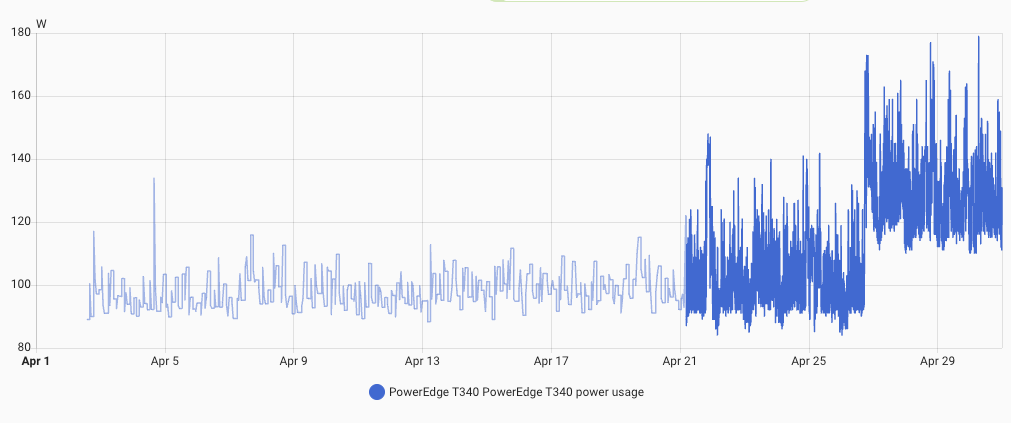
Yes, the server booted the dual 450W power supplies are handling things just fine. The drives spin down quite a bit and unraid is REALLY good at keeping just what is needed spinning and what is incoming cached and distributed to the parity drives and the one or 2 drives that will store the content. Unraid is wild and works so well for what I'm doing.
